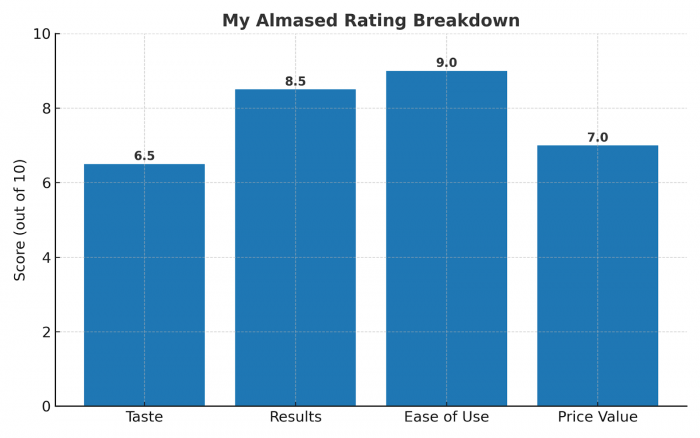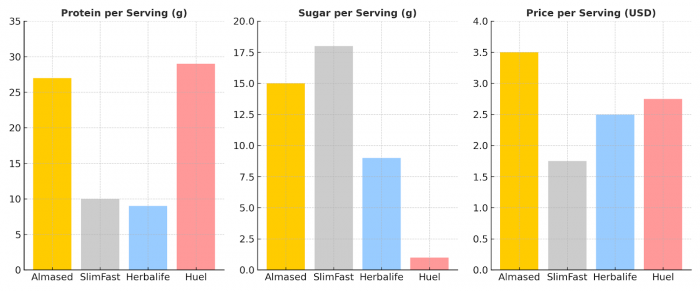On This Page
- Snapshot Verdict
- Breaking Down Almased Nutrition Facts and Benefits
- How Almased Compares to Other Meal Replacement Shakes
- The Almased Plan Phases Explained
- Does It Work? Research Roundup, Minus the Hype
- Almased Weight Loss Results Over Time
- Does Almased Help Control Blood Sugar? My Observations
- Taste, Texture, and Mixability (The Unfiltered Truth)
- Almased Taste Hacks from Real Users
- Side Effects, Allergens, and Who Should Skip It
- Almased Price Breakdown Across Retailers
- How I Used It: My Protocol, Prep, and Compliance Tricks
- Pros (Specific Wins I Noticed)
- Cons (Specific Friction You’ll Likely Feel)
- Smart Alternatives I’d Consider
- Almased Diet Plan PDF and Resources
- Where to Buy Almased and Get an Authentic Product
- Almased Before and After Stories
- Conclusion: My Final Word on Almased
- FAQ
When I first heard about Almased, I wasn’t convinced it could live up to the hype. Meal replacement shakes have burned me before — chalky textures, strange aftertastes, and promises that never materialized. But Almased kept popping up in weight loss forums, diabetes support discussions, and even on Amazon reviews with claims of real, sustained results.
I decided to try it not just as a quick-fix, but to see if it could be part of a realistic, maintainable health plan. My goals? Lose a few stubborn kilos, control evening cravings, and test if the low-glycemic formula really kept my blood sugar steady.
Before you dive into the deep details, let me give you a quick, honest verdict so you can see where I stand.
Snapshot Verdict
- Overall Rating: 7.9/10
- Taste: 6.5/10
- Results: 8.5/10
- Ease of Use: 9/10
- Price Value: 7/10

Yes, Almased can support weight loss and stable energy. It works best as a structured short-term plan but has trade-offs in taste, strictness, and cost.
Now that you have my high-level take, let’s break down the nutrition to understand what you’re really putting in your body.
Breaking Down Almased Nutrition Facts and Benefits
Per 50g serving (≈180 calories):
- 27g protein (non-GMO soy + skim yogurt powder)
- 15g carbs (raw honey, low glycemic index of 27)
- 1g fat
Beyond macros, Almased adds essential vitamins and minerals, though not in the high doses of a full multivitamin. The key benefit here is satiety: the protein + low-GI carb combo means you feel fuller longer without sugar crashes, something echoed repeatedly on Trustpilot reviews.
Now that you know the numbers, it’s worth seeing how Almased stacks up against other shakes you might be considering.
How Almased Compares to Other Meal Replacement Shakes
Compared to something like Herbalife, Almased has less sugar and no artificial flavors, though it’s still naturally sweet from honey. Against SlimFast, it wins on protein quantity but loses in flavor variety. Compared to Huel, Almased is more minimal in ingredients — great for clean-label fans but less nutrient-diverse.

This lean ingredient list means you know exactly what’s going in, but it also means less flavor masking, which affects taste.
Of course, the shake is only part of the equation — the real structure comes from the Almased plan.
The Almased Plan Phases Explained
- Starting Phase – 3 shakes daily, no solid meals (≈1 week).
- Reduction Phase – Shakes for breakfast + dinner, solid lunch.
- Stability Phase – 1 shake daily + balanced meals.
- Life Phase – Maintenance; shake as needed.
It removes decision fatigue, but, first phase can be mentally/socially difficult
But structured plans mean nothing if they don’t actually deliver results, so I dug into the science.
Does It Work? Research Roundup, Minus the Hype
Almased has been tested in studies like the ACOORH trial, showing weight reduction, better insulin markers, and reduced inflammation over months. However, many of these studies were small and sometimes funded by the brand, which is worth noting.
That said, independent nutritionists agree that high-protein, low-GI meal replacements can work if adhered to — Almased just packages that formula in a simple scoop.
Clinical data is one thing, but I wanted to know if everyday users saw the same benefits.
Almased Weight Loss Results Over Time
From scanning Amazon and Walmart reviews, most weight loss happens quickly in the first 2–3 weeks, often 5–10 lbs, especially in the strict Starting phase. Long-term losses of 20–40 lbs were reported, but only when the Stability and Life phases were followed diligently.

For many users, the appeal wasn’t just the scale — it was steadier blood sugar and fewer cravings.
Does Almased Help Control Blood Sugar? My Observations
After using it for breakfast, I noticed my mid-morning energy dips vanished. This mirrors comments in diabetes forums where users saw smaller post-meal glucose spikes. The low-GI design seems legit, but it’s not a magic bullet — you still have to watch total carb intake the rest of the day.
Even with stable energy, the taste could make or break whether you stick with it.
Taste, Texture, and Mixability (The Unfiltered Truth)
Unflavored, it’s mildly sweet with a distinct soy-honey profile — not unpleasant, but not a dessert shake either. It blends smooth in a blender, slightly grainy in a shaker. Some iHerb reviewers called it “drinkable but plain,” others couldn’t get past the taste.
Luckily, there are plenty of tricks to improve it without blowing the nutrition.
Almased Taste Hacks from Real Users
Popular add-ins from Reddit nutrition threads include cinnamon, unsweetened cocoa, almond extract, instant coffee, and blending with unsweetened almond milk instead of water. I personally loved adding a dash of vanilla extract to make it more like a smoothie.
Of course, flavor is just one consideration — your body’s reaction matters even more.
Side Effects, Allergens, and Who Should Skip It
Common issues mentioned on Trustpilot include bloating, gas, and “sweet fatigue” after multiple daily shakes. It contains soy and dairy, so it’s unsuitable for those with related allergies. Thyroid patients should check with their doctor due to soy’s potential effect on medication absorption.
If you’re good to go health-wise, the next factor is whether it fits your budget.
Almased Price Breakdown Across Retailers
Prices range from $32–$40 per 500g tub on Amazon and CVS. At 10 servings per tub, that’s $3–$4 per serving — comparable to other premium MRPs, but more costly than DIY shakes.
If you do invest, making it work in your daily life is key.
How I Used It: My Protocol, Prep, and Compliance Tricks
I replaced breakfast and dinner for two weeks, then shifted to breakfast-only. Pre-measuring scoops into jars made mornings faster. I also drank plenty of water and added fiber on non-shake meals to stay regular.
After weeks of use, the pros and cons became very clear.
Pros (Specific Wins I Noticed)
- A clear, structured plan removes guesswork
- Noticeable appetite suppression
- Stable energy for hours
- No artificial sweeteners or flavors
But it wasn’t without its drawbacks.
Cons (Specific Friction You’ll Likely Feel)
- Sweetness can get tiring
- Strict starts are socially hard to follow
- The price adds up if used for multiple meals daily
If these bother you, you might explore alternatives.
Smart Alternatives I’d Consider
Soy-free blends, whey/casein mixes, or brands like Huel for more nutrient diversity. DIY shakes with whey, oats, and a multivitamin can also save money.
But if you’re sticking with Almased, having the official plan and resources is handy.
Almased Diet Plan PDF and Resources
The official Almased site offers free PDFs with shake recipes, phase schedules, and tips. These helped me plan grocery shopping around the diet.
Just make sure you buy from a trusted source.
Where to Buy Almased and Get an Authentic Product
I stick to verified sellers on Amazon, major pharmacies like CVS, or official distributors listed on the Almased site to avoid expired or fake tubs.
Seeing other people’s transformations also helped me stay motivated.
Almased Before and After Stories
From brand testimonials to independent blog posts, the pattern was consistent — rapid early weight loss, with long-term success tied to sticking with the plan past the first month.
With all that covered, here’s my own final say.
Conclusion: My Final Word on Almased
After weeks of testing Almased, I can honestly say it delivers on its main promises — steady energy, appetite control, and a structured plan that actually makes sticking to a calorie deficit easier. The low-glycemic formula isn’t just marketing fluff; I noticed fewer mid-morning crashes, and many users on Trustpilot share similar experiences.
It’s not perfect. The taste is divisive, the early strict phase takes mental grit, and the price can add up if you rely on multiple shakes daily. But if you can handle soy, enjoy a sweeter shake profile, and need a no-nonsense reset that doesn’t involve complicated recipes, Almased is a solid choice.
For me, Almased works best as a short-term kickstart — something I’d use for a few weeks to get back on track after slipping into bad habits, rather than a year-round staple. It’s a tool, not a miracle cure, and like any tool, its success depends on how you use it.
If you’re considering trying it, go in with realistic expectations, a plan for flavor tweaks, and a willingness to stick with at least the first two phases. Do that, and you might just see why Almased has earned such a loyal — and vocal — following.
FAQ
Is Almased safe for long-term use?
Almased is safe for short-term weight loss. For long-term use, most nutritionists recommend limiting it to 1 shake a day in the Stability or Life phase.
Can Almased replace 2 meals a day?
Yes. In the Reduction Phase, Almased typically replaces breakfast and dinner while you eat one balanced solid meal at lunch.
Does Almased work without exercise?
Yes, weight loss is possible without exercise, but results are faster and more sustainable when combined with daily activity.
How quickly do you see results with Almased?
Most users report 5–10 lbs lost in the first 2–3 weeks during the strict Starting Phase.
Is Almased available in the US and UK?
Yes. Almased is sold online (Amazon, Walmart, CVS in the US; Boots, Amazon UK in the UK) and through the official Almased site.
Can Almased help with diabetes or prediabetes?
Studies show Almased can reduce blood sugar spikes, but it should only be used under medical supervision if you have diabetes.
Does Almased contain caffeine?
No, Almased is naturally caffeine-free. You can add coffee separately if desired.
What makes Almased different from SlimFast or Herbalife?
Almased is higher in protein (27g per serving), has a low glycemic index, and no artificial sweeteners—unlike many flavored competitors.
Post Comment
Recent Comments
Jessica Morgan
Aug 25, 2025“I went into Almased mostly curious—could one powder really keep me full? Surprisingly, it did. I used it for breakfast and lunch, and I didn’t get that usual 3 PM crash at work. The downside was taste fatigue. By the second week, I honestly dreaded the sweetness. I experimented with vanilla drops and cold brew coffee in the shake, which made it much better. I lost about 2.5 kilos in a month, but more importantly, my blood sugar swings felt less intense. I wouldn’t call it a forever solution, but for a reset, it did what it promised.






Christopher Reed
Aug 25, 2025“Almased wasn’t a magic bullet for me, but it gave me structure and a jumpstart. I liked how full I felt after drinking it—I didn’t need snacks between meals, which is rare for me. But it’s also restrictive in the beginning, and you really have to plan around social life. For taste, adding cinnamon was a lifesaver. Over four weeks, I lost 4 kilos and kept most of it off after transitioning back to normal meals.